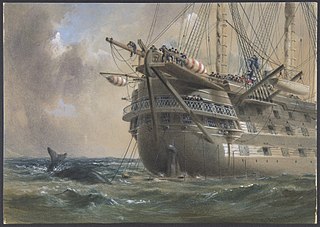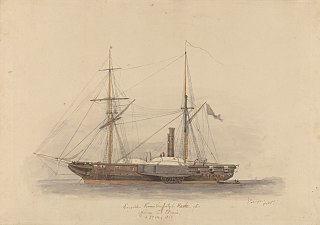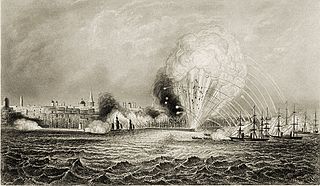
Steam frigates and the smaller steam corvettes, steam sloops, steam gunboats and steam schooners, were steam-powered warships that were not meant to stand in the line of battle. The first such ships were paddle steamers. Later on the invention of screw propulsion enabled construction of screw-powered versions of the traditional frigates, corvettes, sloops and gunboats.

HMS Albion was a 90-gun second-rate ship of the line of the Royal Navy. Ordered in 1839, she was built at Plymouth Dockyard, launched on 6 September 1842, and completed on 23 January 1844. Albion was designed by Sir William Symonds, was the only ship of her class to ever serve as a sailing ship, and the last British two-decker to be completed and enter service without a steam engine. She was the name ship of a class of three second rates—the others being Aboukir and Exmouth.

HMS Agamemnon was a Royal Navy 91-gun battleship ordered by the Admiralty in 1849, in response to the perceived threat from France by their possession of ships of the Napoléon class.

HMS Vulture was one of three 6-gun, steam-powered Cyclops-class second-class paddle frigates built for the Royal Navy in the 1840s. She was initially deployed to the East Indies where she participated in actions against China and then played a minor role in the Crimean War of 1854–1855. The ship was sold for scrap in 1863.

HMS Furious was a 16 gun steam powered paddle wheel frigate of the Royal Navy built at Portsmouth Dockyard and launched on 26 August 1850. She was the lead ship of the two ship class of Furious-class frigate. She was built at a cost of £64,794, of which her machinery cost £24,577.

HMS Terrible was when designed the largest steam-powered wooden paddle wheel frigate built for the Royal Navy.
Admiral Sir William Houston Stewart, was a senior British naval officer who, after a long, active career, eventually held the office of the Controller of the Royal Navy from 1872 to 1881.

HMS President was a large frigate in the British Royal Navy (RN). She was built to replace the previous HMS President, redesignated from the heavy frigate USS President built in 1800 as the last of the original six frigates of the United States Navy under the Naval Act of 1794. The first President had been the active flagship of the U.S. Navy until captured while trying to escape the Royal Navy blockade around New York in 1815 at the end of the War of 1812, and then served in the RN until broken up in 1818. The new British President was built using her American predecessor's exact lines for reference, as a reminder to the United States of the capture of their flagship – a fact driven home by President being assigned as the flagship of the North America and West Indies Station in the western Atlantic Ocean under the command of Admiral Sir George Cockburn (1772–1853), who had directed raids throughout the Chesapeake Bay in 1813–1814 that culminated in the 1814 burning of official buildings in the American capital, Washington, D.C.

HMS Niger was originally slated to be built as a Sampson designed sloop; however, she was ordered as a First-Class sloop with screw propulsion on 20 February 1845 to be built at Woolwich Dockyard, along the design developed by Oliver Lang and with a hull like the Basilisk designed paddle sloops. Her armament and engine were to be like the Encounter Design building at Pembroke. A second vessel (Florentia) was ordered on 26 March 1846 but after her keel was laid at Pembroke Dockyard, her construction was suspended on 6 October 1846 then cancelled three years later, on 22 May 1849. Niger She conducted important propulsion trials, finally proving the superiority of screw propulsion and served in West Africa, the Crimea, China, the East Indies and Australia. She took part in the New Zealand wars in 1860 and was sold for breaking in 1869.

HMS Phoenix was a 6-gun steam paddle vessel of the Royal Navy, built in a dry dock at Chatham in 1832. She was reclassified as a second-class paddle sloop before being rebuilt as a 10-gun screw sloop in 1844–45. She was fitted as an Arctic storeship in 1851 and sold for breaking in 1864.

HMS Basilisk was a first-class paddle sloop of the Royal Navy, built at the Woolwich Dockyard and launched on 22 August 1848.

HMS Barracouta was the last paddle sloop built for the Royal Navy. She was built at Pembroke Dockyard and launched in 1851. She served in the Pacific theatre of the Crimean War, in the Second Opium War and in the Anglo-Ashanti wars. She paid off for the last time in 1877 and was broken up in 1881.

The Hydra class were a class of three paddlewheel steam sloops of the British Royal Navy. They saw active service variously in the Baltic during the Crimean War, against Ottoman forces in Syria and against slavers in West Africa. Latterly, Hydra and Hecate were used for surveys in the Mediterranean, the Pacific, Australia and the Atlantic, and thus their names were re-used for the Hecla-class survey vessels in the late 20th century. Two of the classes were broken up after more than twenty-five years of service, and Hecla was sold for commercial use in 1863.

HMS Arethusa was a 50-gun fourth-rate sailing frigate of the Royal Navy launched in 1849 from the Pembroke Dockyard. The fourth naval ship to bear the name, she served in the Crimean War and then in 1861 was converted to a steam screw frigate. Decommissioned in 1874, Arethusa became a school and training ship on the River Thames, preparing young boys for maritime careers, until she was broken up in 1934.

HMS Magicienne was the lead ship of her class of two 16-gun, steam-powered second-class paddle frigates built for the Royal Navy in the 1850s. Commissioned in 1853 she played a small role in the Crimean War of 1854–1855 and was sold for scrap in 1866.

HMS Encounter was ordered as a First-Class Sloop with screw propulsion on 5 February 1845 to be built at Pembroke, in accordance with the design developed by John Fincham, Master Shipwright at Portsmouth. Her armament was to consist of 8 guns. She was to have a more powerful steam engine rated at 360 nominal horsepower. In 1848 she would be altered abaft and lengthened at Deptford prior to completion. A second vessel (Harrier) was ordered on 26 March 1846 but after her keel was laid at Pembroke Dockyard, her construction was suspended on 9 September 1846 then cancelled five years later, on 4 April 1851. Encounter had her armament radically altered in 1850 and she was broken up at Devonport in 1866.

The Bombardment of Odessa was an action during the Crimean War in which a joint Anglo-French squadron of warships attacked the Russian port of Odessa.

HMS Cyclops was a paddle wheel steam frigate built for the Royal Navy and launched in 1839 and taken out of service in 1861 and sold for breaking in January 1864. She saw action in the Syrian War in 1840 and the Crimean War in 1854, later being involved in laying the first Transatlantic telegraph cable in 1858.

HMS Sylph was a 16-gun Albatross-class brig-sloop of the Royal Navy designed by William Rule and launched in 1795 at Deptford Dockyard. Her namesake was the air spirit sylph. She commissioned in August 1795 under Commander John Chambers White, who would have her until the end of 1799. She was later commanded by Charles Dashwood.
Vice-Admiral Philip Wodehouse was a Royal Navy officer. A son of John Wodehouse, 1st Baron Wodehouse, he joined the navy some time before 1794. In 1796 he was promoted to commander and then captain, commanding sloops and frigates in the Mediterranean Fleet. Wodehouse cycled through a series of frigate commands towards the end of the French Revolutionary Wars, including HMS Mignonne which he had to burn as useless in 1797. In 1803, while commanding HMS Resistance, his ship was wrecked off Cape St Vincent. Wodehouse subsequently commanded several ships of the line, including HMS Cumberland in the Mediterranean where in 1809 he fought at the Battle of Maguelone. Wodehouse was appointed Resident Commissioner, Halifax, in 1811 and served there until the dockyard was closed in 1819. He was promoted to rear-admiral later in the year. Wodehouse saw no further active service, but was promoted to vice-admiral in 1830.





















